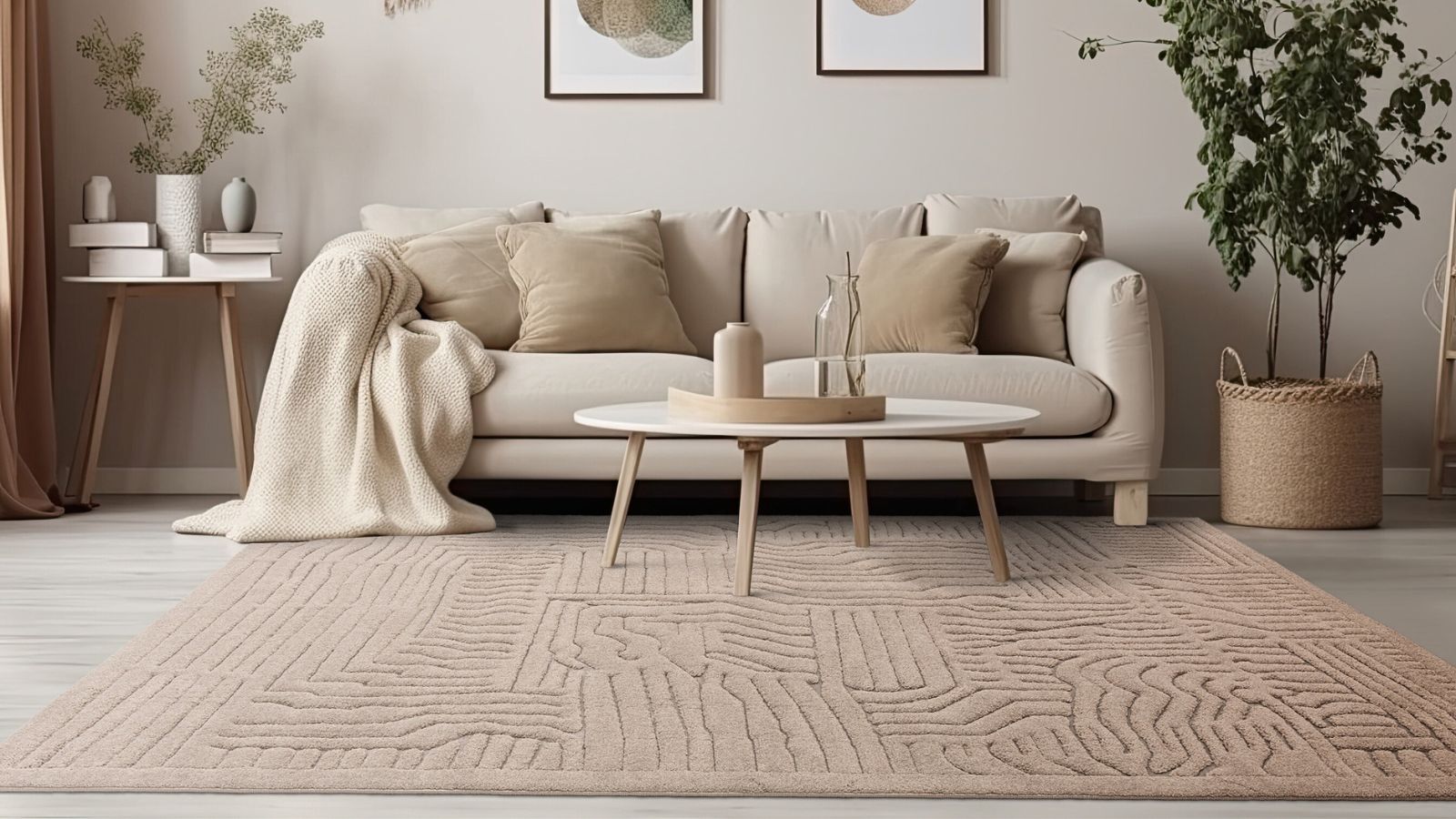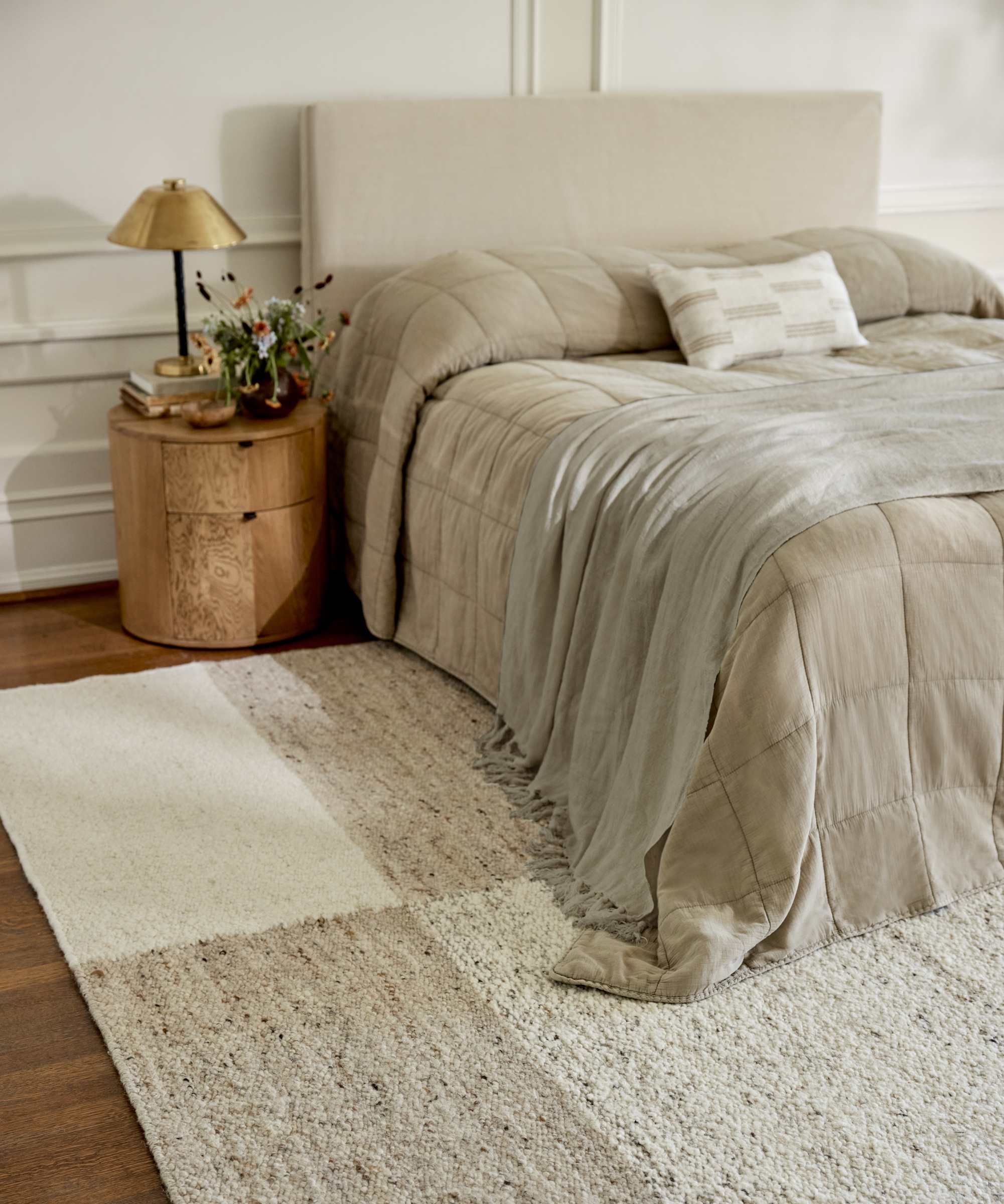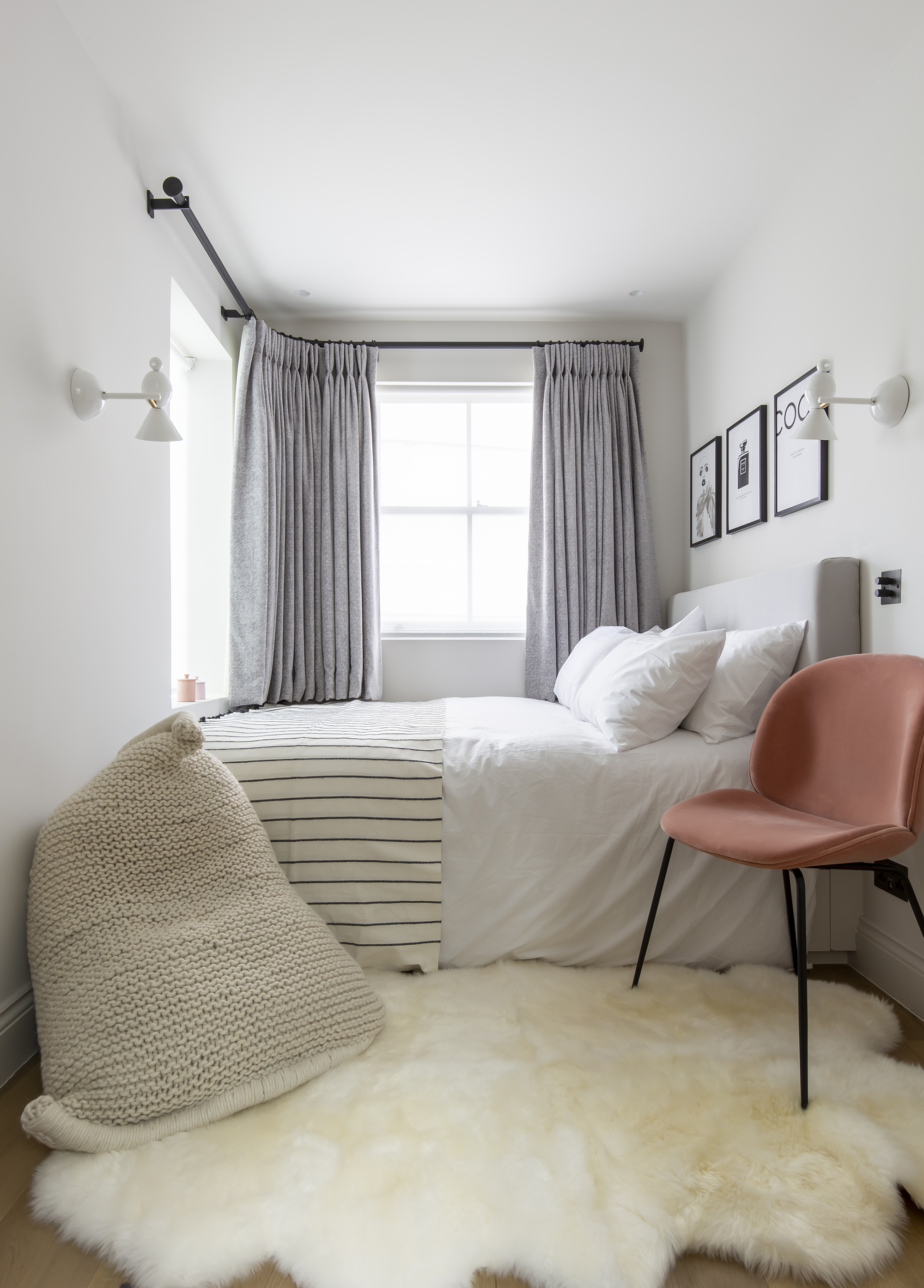How to clean an area rug – 5 steps to revive your rugs
Say goodbye to stains with these five tips to revive your area rugs

Lucy Searle

Unless you opted for a machine washable area rug, cleaning an area rug can be a serious undertaking – especially if you do not have a carpet cleaner that can do most of the work for you.
Nevertheless, knowing how to clean an area rug properly is vital to its longevity. It may be that your rug is in a bedroom, where it doesn't get a ton of footfall, but might occasionally become victim to an early morning coffee spillage. Or perhaps it's in the kitchen, where it has to cope with all kinds of stains and spills – or out in the backyard, in which case it may even have to cope with BBQ stains, too.
Whatever, cleaning a rug can be done at home effectively, without the need to involve professionals. Below, we offer expert cleaning tips for freshening up rugs, the right way.
How to clean an area rug
'Rugs are extremely practical as well as an instant interior design update for all rooms in the home, but whether they’re subject to heavy footfall, everyday spillages, pets or just daily dust – they all need a regular clean,' says Daniel Prendergast of The Rug Seller. 'As well as dirt, rug fibers can house millions of micro-organisms, so a clean helps to prevent a build-up of microbes which is beneficial to a healthy home – especially for people with allergies.
'For any stains and embedded dirt, how these are dealt with can depend on the type of rug fiber. A starting point is to check your product’s care label or follow cleaning guides for certain material types,' Daniel continues.
Below, we bring you expert tips on cleaning a rug, whatever its material or size, and whether you’re caring for it as part of cleaning a living room or in any other location.

1. Start with the vacuum
'One of the most important first steps is to thoroughly vacuum the rug,' begins Kristopher Ayoub, owner at Ayoub N&H and oriental rug expert. 'Even better if you're able to take it outside and dust it first. Doing this will keep any loose soiling from clumping up and turning into a sort of "mud" that not only wears down the rug fibers but can keep the rug from looking its best after cleaning,' they explain.
Design expertise in your inbox – from inspiring decorating ideas and beautiful celebrity homes to practical gardening advice and shopping round-ups.
To vacuum a rug properly, work with the best vacuum cleaner and work slowly in strips, ensuring you do not race so the vacuum has time to pick up all of the debris. Once you have worked across the rug vertically, turn and complete even strips along the rug horizontally to ensure nothing is left behind.
2. Deodorize with baking soda
One of the leading causes of musty odors in a home is unclean furniture and carpets. To deodorize your rug, start by cleaning with baking soda, suggests Elizabeth Shields, operations manager at Super Cleaning Service Louisville.
'I like to sprinkle the entire surface with Arm & Hammer Baking Soda and let it sit for at least 30 minutes to deodorize. When you're ready to vacuum, start with the highest setting and work your way down, changing directions every so often to get all the gunk out.'
Arm & Hammer Pure Baking Soda, 4 lb | $2.73 at Walmart
Cleaning with baking soda is an easy, eco-friendly way to get a sparkling clean, fresh-smelling home, so it's a good idea to keep some in your utility cupboard.
3. Spot treat stains
'Stains should always be tackled as soon as they happen – time really is of the essence when it comes to removing spillages so mop up as much of the stain as possible and never allow it to dry into the rug,' says Daniel Prendergast, floor care expert.
'On fibers that can generally withstand liquid cleaning, a mixture of equal parts white wine vinegar, dish detergent, and warm water can be used to remove coffee stains and get rid of red wine stains. Remember to spot-test first.
'Removing dried-in pet urine stains from carpets can be tricky – but thankfully not impossible. If you have run out of professional products to try, it might be time to give some natural cleaning methods a go. Cleaning with vinegar is one of the most useful household cleaning agents as it is great at lifting stains and acts as a disinfectant.
'Whilst the area is still wet, cover it with baking soda and gently rub it in. Leave it to dry (this could take a day or so) and then vacuum your rug thoroughly. The stain should have been lifted and any remaining odors removed. For really stubborn stains you may need to repeat the process but perseverance should work in the end.'
4. Wash with detergent
Most household rugs only need mild detergent to refresh their appearance and freshen their scent – and you don't need a carpet shampooing machine, assures Elizabeth Shields, operations manager:
'First, make sure it is sunny outside and that no rain is forecast. Prep your workspace with a broom to sweep any dirt. If you have a clean tarp or a plastic sheet, use that to protect the rug.
Then, use a mild detergent, such as Seventh Generation Liquid Laundry Detergent, available at Walmart, or a dedicated carpet shampoo, and put it in a spray bottle with water. To avoid oversaturating your area rug, I suggest spraying down small sections and scrubbing as you go.
'Once the entire surface has been cleaned, rinse it with a garden hose to make things easier. It’s better to start from one end and work your way to the other end. If you’re satisfied, flip and repeat.
'Once the rug is thoroughly rinsed (make sure there’s no suds or foam remaining that could leave behind a sticky residue) - squeeze to remove any excess. If it’s a big rug, you can roll and then stand on it. Press down firmly so there’s less water left.'
Whilst it's reasonable to ask whether you can wash a rug in the washing machine, usually, the answer is no unless the care label specifies that you can. Most of the time, they're too large for your home's washer.
5. Air out to dry
With the rug cleaned and rinsed, with the majority of the water squeezed out, you must leave the rug to fully dry. This is where working on a warm, sunny day helps, says cleaning expert Elizabeth Shields.
'Let it air dry on a clean surface. I often hang rugs on a clothesline with sturdy clips. Check it every now and then if it’s dry, as for me, it took a whole day. Once it’s good to go, fluff it up and return the rug to its place.'
If you have to bring the rug inside for whatever reason, lay it flat on a clothes horse and place a dehumidifier nearby to help draw out excess moisture. In the absence of a dehumidifier, leave windows open to maintain airflow around the rug and ward off musty odors.
Considerations for different rug materials

Not every area rug is made equal. Some rugs with unusual or natural materials may require more gentle, direct care to avoid staining or damage. Cleaning wool rugs and cleaning jute rugs, for example, look very different.
How to clean a wool rug

'Wool rugs are very hard wearing but require a gentle approach to cleaning,' says Daniel Prendergast, floor care expert. 'Use a specialist wool rug cleaner or mix water and non-bio washing detergent. Firstly, dab with a clean microfiber cloth and then use a dry cloth to remove moisture.
'Allow to dry naturally. Some wool rugs can be steam cleaned but always check with the manufacturer’s specific recommendations.'
How to clean jute and sisal rugs

'Jute and sisal rugs don’t respond well to water so it us best to use a dry shampoo which are sold in most supermarkets,' floor care expert Daniel Prendergast continues.
'Sprinkle the rug with absorbent carpet shampoo granules for an occasional freshening. Work or brush the granules into the rug with the vacuum’s cleaning head bristles without turning on the appliance. Allow the shampoo to sit for the length of time instructed on the label, which may be about one hour. Vacuum the granules out thoroughly.'
How to clean a sheepskin rug

'Sheepskin rugs can be washed by hand, however you may opt to get yours professionally cleaned once a year. Check the label to see if your sheepskin can be machine washed – this will usually be on your washer’s coolest setting,' says Prendergast. 'If your rug is not machine washable, fill a bath with cool water and mix in a specialist sheepskin detergent. Leave the rug in the cool water mixture for 5-10 minutes to loosen any dirt and then rinse thoroughly.
'Dry by patting out excess water and then leaving to air dry, laid flat in a warm place away from direct sunlight. Using a metal bristled sheepskin brush, fluff the wool gently while still damp. Brush it once again, while drying, and do a final brush after it’s dried – your sheepskin will return to its natural fluffiness.'
How to clean a viscose rug

'Viscose rugs are not designed to get wet and if they do will draw water in and become damaged,' warns Prendergast. 'Try to avoid placing your rug somewhere where it may become wet. Spot clean stains as they occur and gently vacuum regular to remove dirt and other fibers.'
FAQs
How often should I clean a rug?
Generally speaking, you should try to clean your rugs around twice a year, more if the rug is in a high traffic, dirty spot such as an entryway, or you spill something on it. Vacuuming weekly in between these deep cleans will help to maintain the look and feel of the rug.
If you want to kill bacteria and freshen up a rug in between deep cleans, consider investing in the best steam cleaners and mops that will penetrate the fibers and break down dirt without the need to scrub the rug by hand.
Why clean a rug if it looks clean?
Even if your rug looks clean, it can be harboring bacteria and bugs, so it is important to clean it regularly. 'In general, when it comes to cleaning all types of rugs, "little and often" is essential to keep them fresh and dust free,' says Daniel Prendergast of The Rug Seller. 'In fact, it’s safe to say there may be more than just a bug in your rug if it’s left uncleaned – vacuuming alone won’t remove carpet dust mites which can trigger allergic reactions such as asthma and eczema.'
Of course, while it is possible to clean an area rug by hand, it is a lot easier if you have a carpet shampooing machine at your disposal, adds cleaning expert Elizabeth Sheilds.
'If you have a machine, follow the same process from clearing the area to vacuuming it up. You don’t need to shake it outside, the machine already does the job of grabbing dirt and suctioning up most of the water to help with drying.'
Ditching the habits making your rugs dirtier also helps.

Chiana has been at Homes & Gardens for two years and is our resident 'queen' of non-toxic living. She spends most of her time producing content for the Solved section of the website, helping readers get the most out of their homes through clever decluttering, cleaning, and tidying tips. She was named one of Fixr's top home improvement journalists in 2024.
- Lucy SearleGlobal Editor in Chief
